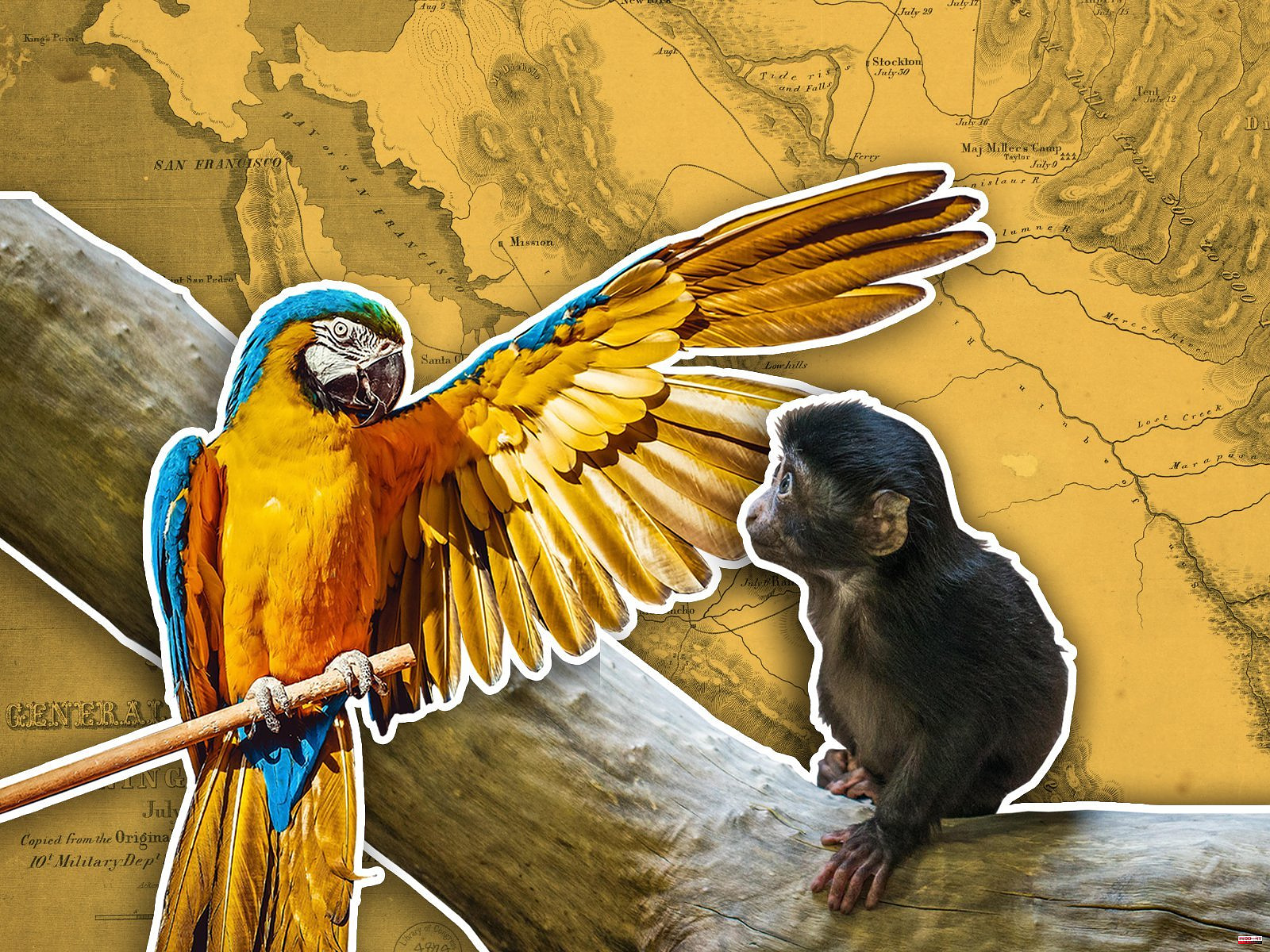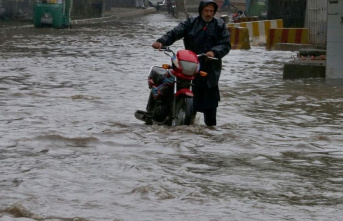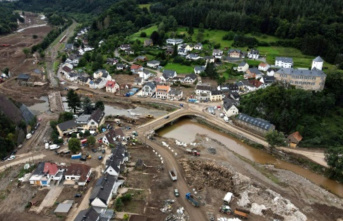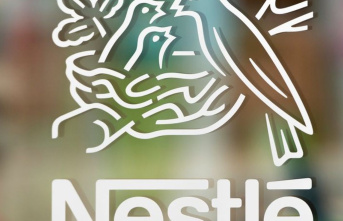After seven weeks of sailing from Nicaragua, five monkeys and fifty parrots arrived in San Francisco in March 1853. The animals were likely to have drawn a crowd as they chattered and squawked on the wharf. Some people gathered to see the parrots' plumage which brought out flashes in scarlet and lime-green on this spring day. Others may have expected the monkeys would put on a show similar to the primates they were familiar with from childhood stories and circuses.
These captive animals were used as street attractions and pets by the newcomers to San Francisco, hoping to make a profit from the Gold Rush. Some monkeys wore blazers and cranked hand-organs.
New evidence has been found that these animals were taken from their natural habitats and brought to San Francisco in 1850s. Although details about the importers are not available, it is possible that they nabbed these animals opportunistically as they ferried U.S. East Coasters across the southern landmasses to San Francisco. Others went on business to market products, including live fauna, from Central and South America. Cyler Conrad, an archaeologist from Los Alamos National Laboratory, and the University of New Mexico, delved into archives of historical documents, and found archaeological evidence to shed light on the animal trade. His findings were published in March in Ethnobiology Letters. They describe how city dwellers imported monkeys to entertain themselves.
These unwitting pets join an increasing number of animals that were affected by the Gold Rush. This list also includes Tule Elk, which miners hunted from near extinction to an endangered species that was only found in California. In 1895, there were only 30 remaining elk. However, the population has increased to 5,700 today thanks to new laws. Giant tortoises, which were captured in the Galapagos Islands, were also among the animal fatalities. They were transported to San Francisco and made into stews, steaks, and pies. The whalers' earlier century appetites meant that the tortoise population was already at risk. They are still on the IUCN Red List of Threatened Species, despite the Gold Rush demand for their meat. Conrad and others have added these animals to Gold Rush history to give a more complete and grimmer picture of the period's ethos as well as its ecological toll.
In 1848, a carpenter discovered gold flakes in a river 130 miles east from San Francisco. This was the beginning of the Gold Rush. The discovery coincided with the Mexican-American War being ending. A few days later, Mexico gave California to the United States.
Rumours about California's gold quickly spread. The claims were disputed by Americans on the East Coast, so President James K. Polk sent an investigator. Polk had received the report by the end of the year and declared in a speech before Congress that the "reports of the abundant gold in that territory were of such extraordinary character that would scarcely command belief if they weren't corroborated."
Tens of thousands of potential miners, also known as Argonauts or 49ers, began to flock to northern California in 1849. Although most of these immigrants were from the east, some traveled from further lands such as Australia, South America and China. According to Allen Pastron, an archaeologist from the Bay Area who wasn't involved in the study, they arrived at San Francisco's harbor aboard "a tsunami of vessels".
California's Indigenous population was already suffering violence, murder, and disease under Spanish imperialism. The new wave American settlers terrorized them. California's first governor and state legislature passed the "Act for the Government and Protection of Indians" in 1850. This law allowed white officials to seize Native American land and children. The law also stipulated that Native testimony could not be used to convict white men. This allowed white 49ers to rape and murder Native Americans in California. Scholars and politicians both call the 49ers genocide for their atrocities and injustices.
Conrad says that there was "massacre and murder of Indigenous people." It's a sad record. In 1880, California had 16,277 Native Americans, as opposed to the 150,000 who lived there before the U.S. invaded.
Although 49ers originally came to the gold mines to try their luck, many made their fortunes in San Francisco as professionals or merchants. In just one year, San Francisco grew from a small 800-person hamlet into a city of more than 20,000 people. The growth of the population was faster than the construction of buildings and infrastructure such as docks and bridges. Tents were pitched on hillsides by newcomers. Rats were rampant and fires were a regular occurrence. Because there was no pavement in the city, streets were filled with mud, garbage, and rotting carcasses.
According to accounts, pedestrians were sometimes submerged in the mud. This is similar to the woman who was mentioned in an 1852 Daily Alta California News story: "The lady was bodily imprisoned in the mud, but was rescued by some gentlemen." At every step, you can see large, gaping holes that could swallow a small group.
Conrad says, "It was such an wild, turbulent place." It would make a wonderful HBO-type series.
Conrad, an archaeologist who studies animal bones, wanted to understand how the 1850s influx in humans affected the wildlife of northern California. He began his work at the Gold Rush-era sites Pastron was excavating a decade back. Conrad and Pastron analyzed bones, shells, and other bits of animal material to chart the diets of city dwellers over the period. This was published in 2015 in the International Journal of Historical Archaeology.
This archaeological evidence was consistent with 19th-century historical records. Beef was the primary source of protein for the region's European-descended people during the 1840s. The cattle stock was not sufficient to feed the Gold Rush settlers. They turned to wild fish, and other game. San Francisco's markets were flooded with whole cart loads of ducks, geese and other wild fowl, as well as countless quarters of bears, elks, antelopes, deer, and other smaller game," wrote a journalist back then. Wild game was a staple food and then a luxury food. That's because the Argonauts quickly discovered and destroyed native species.
It was so exploitative. They came in. They took these lands. Conrad says that then they began to mine these lands and essentially kill any food they could eat." Conrad says that there is no local wildlife that has not been affected by the human transformations of western North America.
The ecological impact went beyond California. Conrad and his colleagues identified imported foods in a series papers published between 2015-2020. They included turkeys, East Coast oysters, and Atlantic cod. The latter was sourced via DNA analysis. The seafood had to be preserved in transport. It was likely that the seafood was dried, salted, or canned. Researchers also found the remains of Galapagos giant tortoises and sea turtles, which were brought 3,300 miles to feed hungry Argonauts.
Conrad also studied animal remains and searched 19th-century documents in order to better understand the trade in animals. Conrad discovered that many animals had arrived from other countries to get food. To combat the city's rats, house cats were brought from Mexico. Kangaroo skins, which were considered a luxurious textile, and sometimes live kangaroos were brought by ships from Australia. Newspapers from that time reported that one kangaroo owner charged one per eye and that a saloon owner delighted guests with a "real live Kangaroo."
Conrad claims that monkeys and pararots were caught much like kangaroos in his new paper. Conrad discovered shipping records that confirm the species arrived in California aboard vessels from Central and South America. The images and descriptions indicate that the primates were capuchins or howlers. It is possible that the parrots belonged to several species, including scarlet macaws and spider monkeys.
Pastron says that the fact that exotic animals were found in places where most people had never seen them before, and in many cases never heard about them, was just one aspect of the unique and unmatched dynamism of San Francisco in that period.
Conrad discovered a 19th century cartoon in which passersby are simultaneously entertained and antagonized on a roof by monkeys. Another photo shows primates stooping in front of caged birds. Residents and visitors to Gold Rush San Francisco mention parrots, monkeys, and other animals in letters, news stories, and other writings.
A bar patron was lured into the street by "long forgotten but cherished... dulcet tones". In 1850, a traveler was shocked to see a monkey playing a hand-organ. He wrote, "clambering from pillar to pillar, grinning at all the many presents of fruit and biscuit that he received." The observer also noted the monkey's appeal and added, "The melodious sounds of his instrument never failed aroused the enthusiasm of those who are homeless, while the tricks of the monkey served as amusement for the leisurely of rough miners."
Conrad did not find any parrot or monkey bones in the collections that he meticulously examined for his earlier studies. Other archaeologists, however, have found bones from parrots that were likely kept at San Francisco sites as pets. These bones date to the 1870s or 1880s, a few decades after the Gold Rush. An early 19th-century Charleston, South Carolina boarding house is the only known source of bones from a possible pet parrot.
Martha Zierden, an archaeologist who examined the Charleston skeleton, says that comparing the East Coast and West Coast parrots is "certainly the same behavior [of pet keeping]". Charleston, a port city like San Francisco was connected to global trade. Thus, keeping exotic animals in Charleston may have been considered a status symbol. Zierden, the Charleston Museum's curator of historical archaeology, discovered a 1789 portrait which supports her case. The painting was found in Annapolis, Maryland and hanged in a historic home. It depicts a young girl with a small parrot sitting on her back.
Daniel Lewis, an environmental historian, was not part of Conrad's research. He finds it convincing, however, that monkeys, parrots, and other animals were brought to San Francisco in 19th-century San Francisco for companionship and entertainment. He says that the findings raise new questions about the lives and needs of city residents. Lewis, a Huntington curator, asks, "Were they lacking entertainment in Gold Rush California?" "Why did they bring these creatures in?"
Conrad believes that the animals were an emotional distraction for 49ers who moved to a new area with strange sights, smells, and experiences. He says that the environment they found in northern California, with the rush for gold and chaos, would have been a good fit for the animals because they were exotic and new.












